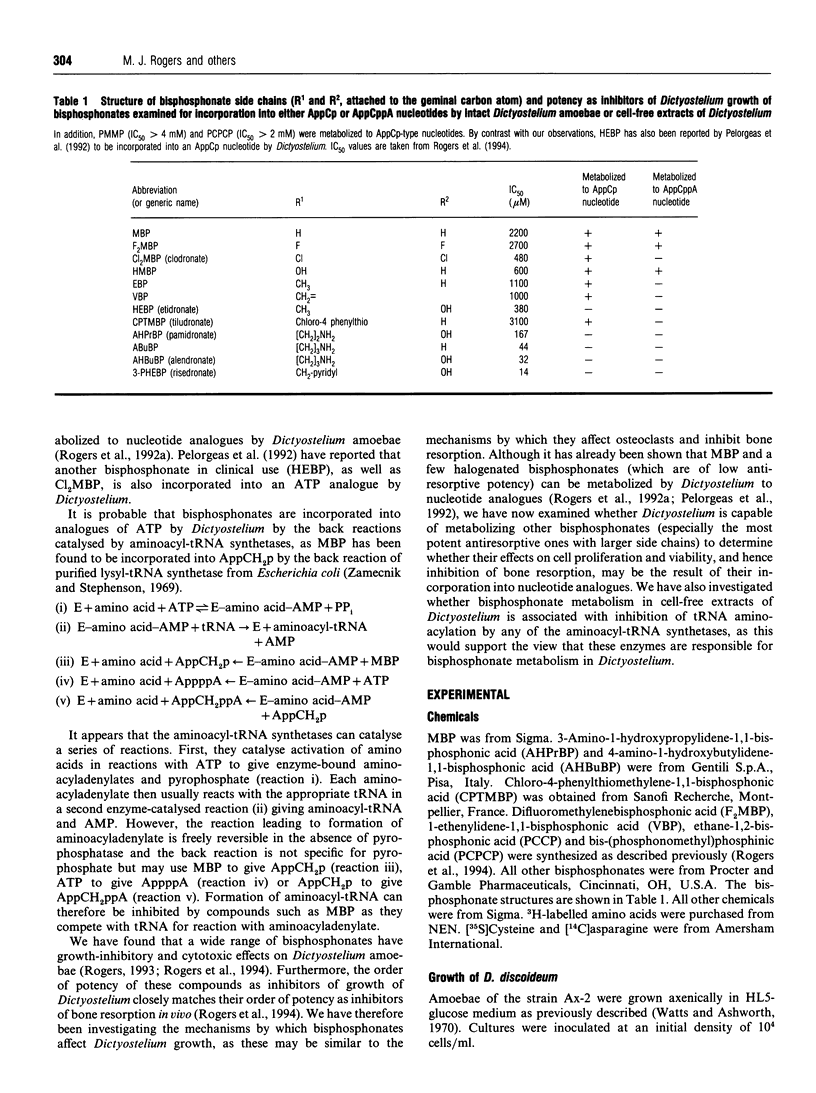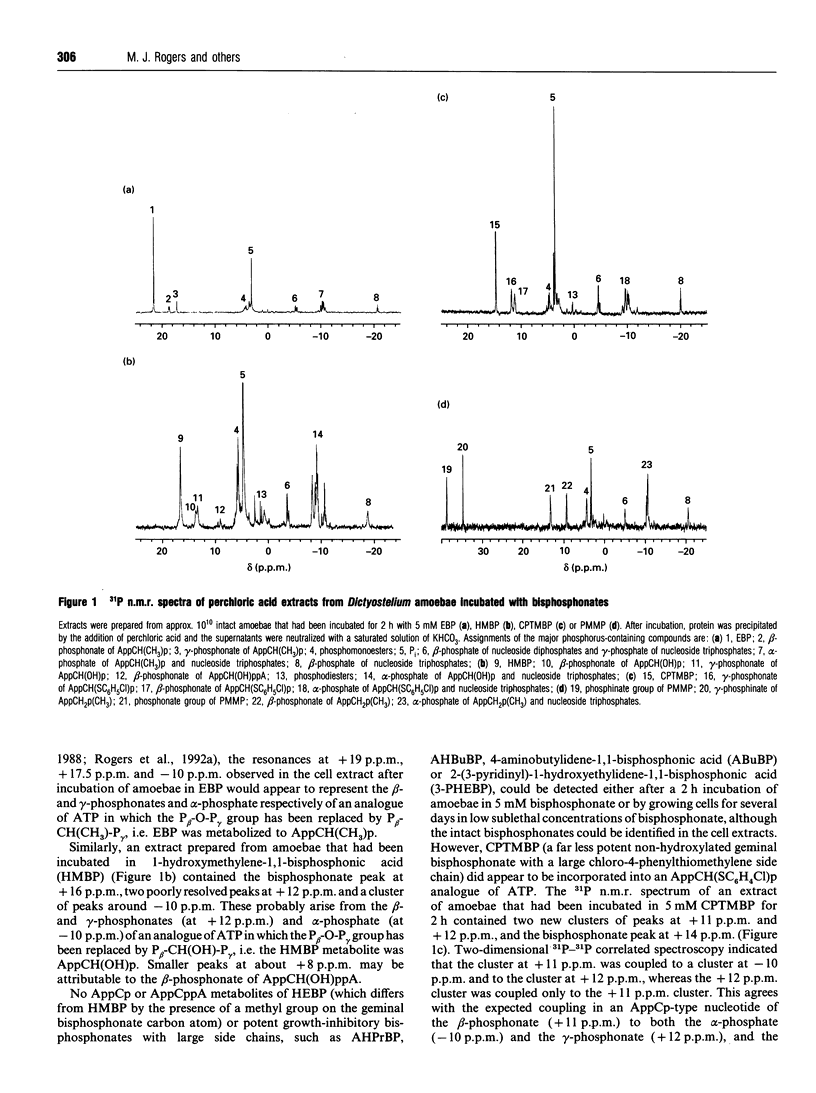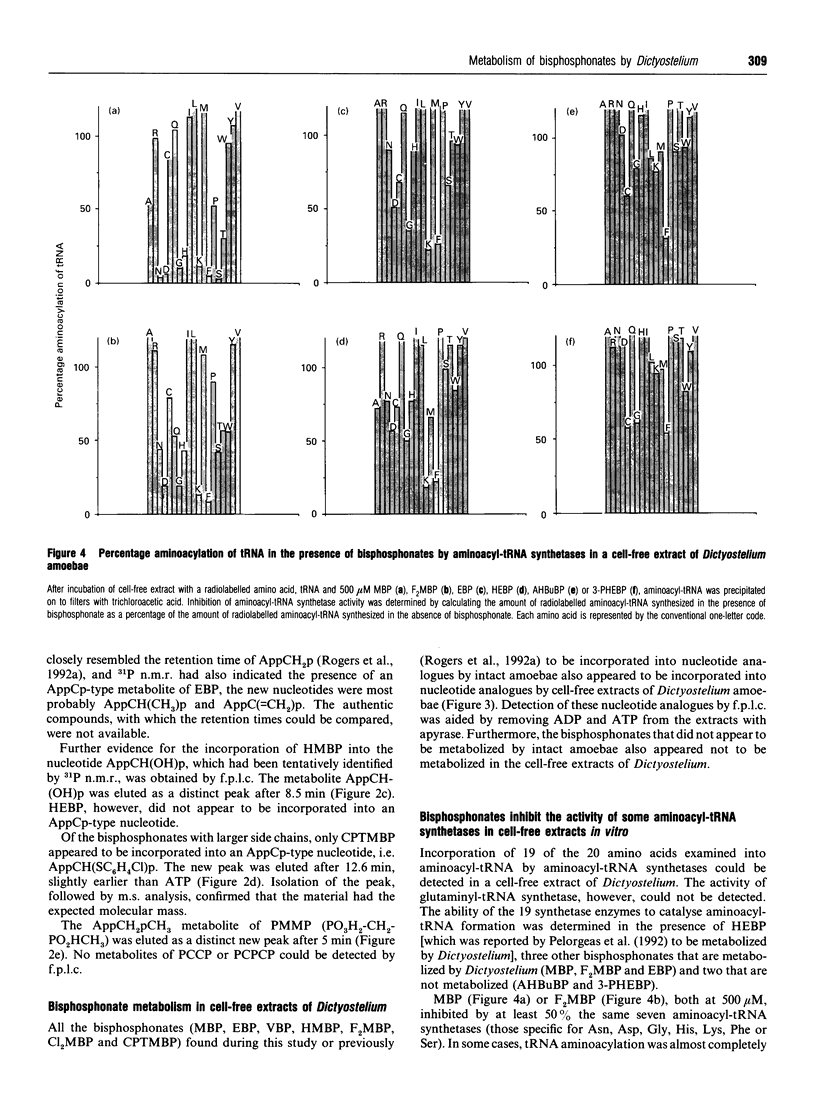Abstract
Bisphosphonates are a class of synthetic pyrophosphate analogues. Some are known to be potent inhibitors of osteoclast-mediated bone resorption in vivo, but their mechanisms of action are unclear. The order of potency of bisphosphonates as inhibitors of bone resorption closely matches the order of potency as inhibitors of growth of amoebae of the slime mould Dictyostelium discoideum, indicating that bisphosphonates may have a mechanism of action that is similar in both osteoclasts and Dictyostelium. Methylenebisphosphonate and several halogenated derivatives, which have low potency as antiresorptive agents and as growth inhibitors of Dictyostelium, are metabolized intracellularly by Dictyostelium amoebae into methylene-containing adenine nucleotides. We have used a combination of n.m.r. and f.p.l.c. analysis to determine whether incorporation into nucleotides is a feature of other bisphosphonates, especially those that are potent antiresorptive agents. Only bisphosphonates with short side chains or of low potency are incorporated into adenine nucleotides, whereas those with long side chains or of high potency are not metabolized. Bisphosphonate metabolism in cell-free extracts of Dictyostelium was accompanied by inhibition of aminoacylation of tRNA by several aminoacyl-tRNA synthetases. These enzymes were barely affected by the bisphosphonates that were not metabolized. The results indicate that some bisphosphonates are not metabolically inert analogues of pyrophosphate and appear to be metabolized by aminoacyl-tRNA synthetases. The cellular effects of some bisphosphonates may be the result of their incorporation into adenine nucleotides or inhibition of aminoacyl-tRNA synthetases, although the potent bisphosphonates appear to act by a different mechanism.
Full text
PDF








Images in this article
Selected References
These references are in PubMed. This may not be the complete list of references from this article.
- Adami S., Bolzicco G. P., Rizzo A., Salvagno G., Bertoldo F., Rossini M., Suppi R., Lo Cascio V. The use of dichloromethylene bisphosphonate and aminobutane bisphosphonate in hypercalcemia of malignancy. Bone Miner. 1987 Aug;2(5):395–404. [PubMed] [Google Scholar]
- Amin D., Cornell S. A., Gustafson S. K., Needle S. J., Ullrich J. W., Bilder G. E., Perrone M. H. Bisphosphonates used for the treatment of bone disorders inhibit squalene synthase and cholesterol biosynthesis. J Lipid Res. 1992 Nov;33(11):1657–1663. [PubMed] [Google Scholar]
- Boonekamp P. M., van der Wee-Pals L. J., van Wijk-van Lennep M. M., Thesing C. W., Bijvoet O. L. Two modes of action of bisphosphonates on osteoclastic resorption of mineralized matrix. Bone Miner. 1986 Feb;1(1):27–39. [PubMed] [Google Scholar]
- Carano A., Teitelbaum S. L., Konsek J. D., Schlesinger P. H., Blair H. C. Bisphosphonates directly inhibit the bone resorption activity of isolated avian osteoclasts in vitro. J Clin Invest. 1990 Feb;85(2):456–461. doi: 10.1172/JCI114459. [DOI] [PMC free article] [PubMed] [Google Scholar]
- Cecchini M. G., Felix R., Fleisch H., Cooper P. H. Effect of bisphosphonates on proliferation and viability of mouse bone marrow-derived macrophages. J Bone Miner Res. 1987 Apr;2(2):135–142. doi: 10.1002/jbmr.5650020209. [DOI] [PubMed] [Google Scholar]
- Fast D. K., Felix R., Dowse C., Neuman W. F., Fleisch H. The effects of diphosphonates on the growth and glycolysis of connective-tissue cells in culture. Biochem J. 1978 Apr 15;172(1):97–107. doi: 10.1042/bj1720097. [DOI] [PMC free article] [PubMed] [Google Scholar]
- Felix R., Graham R., Russell G., Fleisch H. The effect of several diphosphonates on acid phosphohydrolases and other lysosomal enzymes. Biochim Biophys Acta. 1976 Apr 8;429(2):429–438. doi: 10.1016/0005-2744(76)90291-6. [DOI] [PubMed] [Google Scholar]
- Flanagan A. M., Chambers T. J. Dichloromethylenebisphosphonate (Cl2MBP) inhibits bone resorption through injury to osteoclasts that resorb Cl2MBP-coated bone. Bone Miner. 1989 Apr;6(1):33–43. doi: 10.1016/0169-6009(89)90021-4. [DOI] [PubMed] [Google Scholar]
- Fleisch H. Diphosphonates: history and mechanisms of action. Metab Bone Dis Relat Res. 1981;3(4-5):279–287. doi: 10.1016/0221-8747(81)90044-8. [DOI] [PubMed] [Google Scholar]
- Fleisch H., Russell R. G., Francis M. D. Diphosphonates inhibit hydroxyapatite dissolution in vitro and bone resorption in tissue culture and in vivo. Science. 1969 Sep 19;165(3899):1262–1264. doi: 10.1126/science.165.3899.1262. [DOI] [PubMed] [Google Scholar]
- Hughes D. E., Mian M., Guilland-Cumming D. F., Russell R. G. The cellular mechanism of action of bisphosphonates. Drugs Exp Clin Res. 1991;17(2):109–114. [PubMed] [Google Scholar]
- Mathews M. B., Reichlin M., Hughes G. R., Bernstein R. M. Anti-threonyl-tRNA synthetase, a second myositis-related autoantibody. J Exp Med. 1984 Aug 1;160(2):420–434. doi: 10.1084/jem.160.2.420. [DOI] [PMC free article] [PubMed] [Google Scholar]
- Papapoulos S. E., Landman J. O., Bijvoet O. L., Löwik C. W., Valkema R., Pauwels E. K., Vermeij P. The use of bisphosphonates in the treatment of osteoporosis. Bone. 1992;13 (Suppl 1):S41–S49. doi: 10.1016/s8756-3282(09)80009-4. [DOI] [PubMed] [Google Scholar]
- Pelorgeas S., Martin J. B., Satre M. Cytotoxicity of dichloromethane diphosphonate and of 1-hydroxyethane-1,1-diphosphonate in the amoebae of the slime mould Dictyostelium discoideum. A 31P NMR study. Biochem Pharmacol. 1992 Dec 1;44(11):2157–2163. doi: 10.1016/0006-2952(92)90342-g. [DOI] [PubMed] [Google Scholar]
- Pilczyk R., Sutcliffe H., Martin T. J. Effects of pyrophosphate and diphosphonates on parathyroid hormone- and fluoride-stimulated adenylate cyclase activity. FEBS Lett. 1972 Aug 1;24(2):225–228. doi: 10.1016/0014-5793(72)80772-5. [DOI] [PubMed] [Google Scholar]
- Ralston S. H., Gallacher S. J., Patel U., Dryburgh F. J., Fraser W. D., Cowan R. A., Boyle I. T. Comparison of three intravenous bisphosphonates in cancer-associated hypercalcaemia. Lancet. 1989 Nov 18;2(8673):1180–1182. doi: 10.1016/s0140-6736(89)91791-1. [DOI] [PubMed] [Google Scholar]
- Rogers M. J., Russell R. G., Blackburn G. M., Williamson M. P., Watts D. J. Metabolism of halogenated bisphosphonates by the cellular slime mould Dictyostelium discoideum. Biochem Biophys Res Commun. 1992 Nov 30;189(1):414–423. doi: 10.1016/0006-291x(92)91574-a. [DOI] [PubMed] [Google Scholar]
- Rogers M. J., Watts D. J., Russell R. G., Ji X., Xiong X., Blackburn G. M., Bayless A. V., Ebetino F. H. Inhibitory effects of bisphosphonates on growth of amoebae of the cellular slime mold Dictyostelium discoideum. J Bone Miner Res. 1994 Jul;9(7):1029–1039. doi: 10.1002/jbmr.5650090710. [DOI] [PubMed] [Google Scholar]
- Rowe D. J., Hays S. J. Inhibition of bone resorption by difluoromethylene diphosphonate in organ culture. Metab Bone Dis Relat Res. 1983;5(1):13–16. doi: 10.1016/0221-8747(83)90045-0. [DOI] [PubMed] [Google Scholar]
- Rowe E. J., Hausmann E. The alteration of osteoclast morphology by diphosphonates in bone organ culture. Calcif Tissue Res. 1976 Apr 13;20(1):53–60. doi: 10.1007/BF02546397. [DOI] [PubMed] [Google Scholar]
- Russell R. G., Mühlbauer R. C., Bisaz S., Williams D. A., Fleisch H. The influence of pyrophosphate, condensed phosphates, phosphonates and other phosphate compounds on the dissolution of hydroxyapatite in vitro and on bone resorption induced by parathyroid hormone in tissue culture and in thyroparathyroidectomised rats. Calcif Tissue Res. 1970;6(3):183–196. doi: 10.1007/BF02196199. [DOI] [PubMed] [Google Scholar]
- Sahni M., Guenther H. L., Fleisch H., Collin P., Martin T. J. Bisphosphonates act on rat bone resorption through the mediation of osteoblasts. J Clin Invest. 1993 May;91(5):2004–2011. doi: 10.1172/JCI116422. [DOI] [PMC free article] [PubMed] [Google Scholar]
- Sato M., Grasser W., Endo N., Akins R., Simmons H., Thompson D. D., Golub E., Rodan G. A. Bisphosphonate action. Alendronate localization in rat bone and effects on osteoclast ultrastructure. J Clin Invest. 1991 Dec;88(6):2095–2105. doi: 10.1172/JCI115539. [DOI] [PMC free article] [PubMed] [Google Scholar]
- Schenk R., Eggli P., Fleisch H., Rosini S. Quantitative morphometric evaluation of the inhibitory activity of new aminobisphosphonates on bone resorption in the rat. Calcif Tissue Int. 1986 Jun;38(6):342–349. doi: 10.1007/BF02555748. [DOI] [PubMed] [Google Scholar]
- Sietsema W. K., Ebetino F. H., Salvagno A. M., Bevan J. A. Antiresorptive dose-response relationships across three generations of bisphosphonates. Drugs Exp Clin Res. 1989;15(9):389–396. [PubMed] [Google Scholar]
- Stevenson P. H., Stevenson J. R. Cytotoxic and migration inhibitory effects of bisphosphonates on macrophages. Calcif Tissue Int. 1986 Apr;38(4):227–233. doi: 10.1007/BF02556715. [DOI] [PubMed] [Google Scholar]
- Watts D. J., Ashworth J. M. Growth of myxameobae of the cellular slime mould Dictyostelium discoideum in axenic culture. Biochem J. 1970 Sep;119(2):171–174. doi: 10.1042/bj1190171. [DOI] [PMC free article] [PubMed] [Google Scholar]
- van Rooijen N., Kors N. Effects of intracellular diphosphonates on cells of the mononuclear phagocyte system: in vivo effects of liposome-encapsulated diphosphonates on different macrophage subpopulations in the spleen. Calcif Tissue Int. 1989 Sep;45(3):153–156. doi: 10.1007/BF02556058. [DOI] [PubMed] [Google Scholar]



